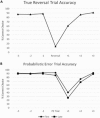Evidence of absence: no relationship between behaviourally measured prediction error response and schizotypy
- PMID: 28697644
- PMCID: PMC5646181
- DOI: 10.1080/13546805.2017.1348289
Evidence of absence: no relationship between behaviourally measured prediction error response and schizotypy
Abstract
Introduction: The predictive processing framework has attracted much interest in the field of schizophrenia research in recent years, with an increasing number of studies also carried out in healthy individuals with nonclinical psychosis-like experiences. The current research adopted a continuum approach to psychosis and aimed to investigate different types of prediction error responses in relation to psychometrically defined schizotypy.
Methods: One hundred and two healthy volunteers underwent a battery of behavioural tasks including (a) a force-matching task, (b) a Kamin blocking task, and (c) a reversal learning task together with three questionnaires measuring domains of schizotypy from different approaches.
Results: Neither frequentist nor Bayesian statistical methods supported the notion that alterations in prediction error responses were related to schizotypal traits in any of the three tasks.
Conclusions: These null results suggest that deficits in predictive processing associated with clinical states of psychosis are not always present in healthy individuals with schizotypal traits.
Keywords: Sensory prediction; associative learning; prediction error; psychosis continuum; reversal learning.
Figures






Similar articles
-
Subnormal sensory attenuation to self-generated speech in schizotypy: Electrophysiological evidence for a 'continuum of psychosis'.Int J Psychophysiol. 2015 Aug;97(2):131-8. doi: 10.1016/j.ijpsycho.2015.05.014. Epub 2015 May 28. Int J Psychophysiol. 2015. PMID: 26027781 Free PMC article.
-
Psychosis-predictive value of self-reported schizotypy in a clinical high-risk sample.J Abnorm Psychol. 2016 Oct;125(7):923-932. doi: 10.1037/abn0000192. Epub 2016 Sep 1. J Abnorm Psychol. 2016. PMID: 27583768
-
Sustained attention deficit along the psychosis proneness continuum: a study on the Sustained Attention to Response Task (SART).Cogn Behav Neurol. 2009 Sep;22(3):180-5. doi: 10.1097/WNN.0b013e3181b7ef84. Cogn Behav Neurol. 2009. PMID: 19741328
-
[Theory of mind and schizotypy: A review].Encephale. 2021 Jun;47(3):254-262. doi: 10.1016/j.encep.2020.10.007. Epub 2021 Feb 26. Encephale. 2021. PMID: 33648750 Review. French.
-
Schizotypal traits and psychotic-like experiences during adolescence: An update.Psicothema. 2017 Feb;29(1):5-17. doi: 10.7334/psicothema2016.209. Psicothema. 2017. PMID: 28126052 Review.
Cited by
-
Different learning aberrations relate to delusion-like beliefs with different contents.Brain. 2024 Aug 1;147(8):2854-2866. doi: 10.1093/brain/awae122. Brain. 2024. PMID: 38637303 Free PMC article.
-
Perceptual sensory attenuation in chronic pain subjects and healthy controls.Sci Rep. 2022 May 27;12(1):8958. doi: 10.1038/s41598-022-13175-4. Sci Rep. 2022. PMID: 35624306 Free PMC article.
-
Cannabis Use, Schizotypy and Kamin Blocking Performance.Front Psychiatry. 2021 Nov 23;12:633476. doi: 10.3389/fpsyt.2021.633476. eCollection 2021. Front Psychiatry. 2021. PMID: 34887781 Free PMC article.
-
Statistical Learning and Inference Is Impaired in the Nonclinical Continuum of Psychosis.J Neurosci. 2020 Aug 26;40(35):6759-6769. doi: 10.1523/JNEUROSCI.0315-20.2020. Epub 2020 Jul 20. J Neurosci. 2020. PMID: 32690617 Free PMC article.
References
MeSH terms
Grants and funding
LinkOut - more resources
Full Text Sources
Other Literature Sources
Medical
